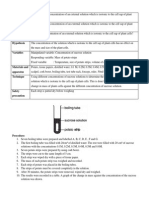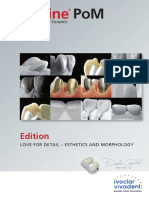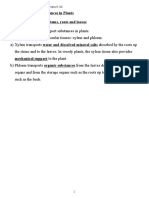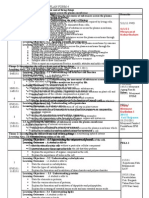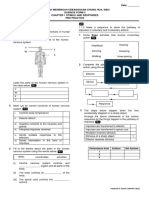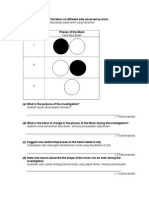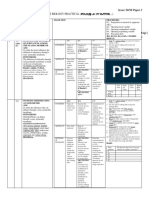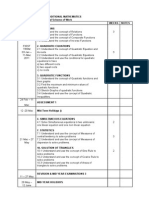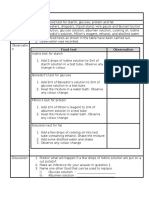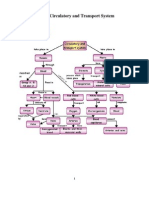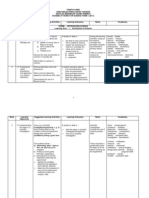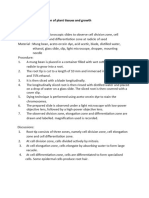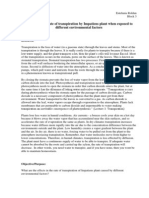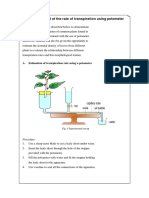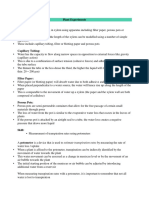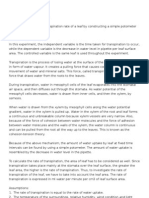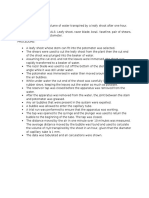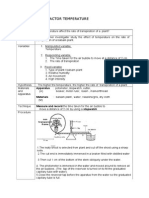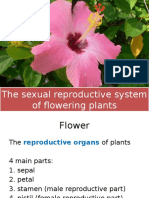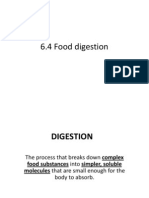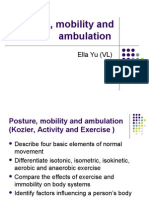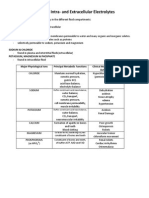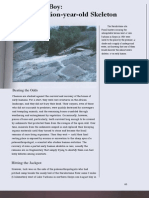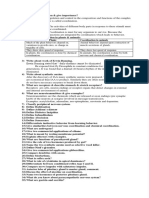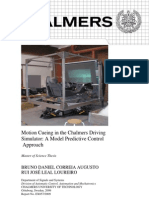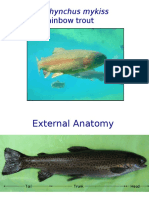0 ratings0% found this document useful (0 votes)
1K viewsForm 5 Biology Peka
Form 5 Biology Peka
Uploaded by
Shirmei WangThe document describes an experiment to examine the structure of flowering plants in relation to water transport. A balsam plant is placed in eosin solution so that the dye is absorbed by the tissues involved in water transport. Thin sections of the stem and root are then examined under a microscope and the tissues stained by the eosin are identified and labeled in a diagram. This allows observation of the structures responsible for water conduction in flowering plants.
Copyright:
© All Rights Reserved
Available Formats
Download as DOCX, PDF, TXT or read online from Scribd
Form 5 Biology Peka
Form 5 Biology Peka
Uploaded by
Shirmei Wang0 ratings0% found this document useful (0 votes)
1K views4 pagesThe document describes an experiment to examine the structure of flowering plants in relation to water transport. A balsam plant is placed in eosin solution so that the dye is absorbed by the tissues involved in water transport. Thin sections of the stem and root are then examined under a microscope and the tissues stained by the eosin are identified and labeled in a diagram. This allows observation of the structures responsible for water conduction in flowering plants.
Original Description:
peka
Original Title
form 5 biology peka
Copyright
© © All Rights Reserved
Available Formats
DOCX, PDF, TXT or read online from Scribd
Share this document
Did you find this document useful?
Is this content inappropriate?
The document describes an experiment to examine the structure of flowering plants in relation to water transport. A balsam plant is placed in eosin solution so that the dye is absorbed by the tissues involved in water transport. Thin sections of the stem and root are then examined under a microscope and the tissues stained by the eosin are identified and labeled in a diagram. This allows observation of the structures responsible for water conduction in flowering plants.
Copyright:
© All Rights Reserved
Available Formats
Download as DOCX, PDF, TXT or read online from Scribd
Download as docx, pdf, or txt
0 ratings0% found this document useful (0 votes)
1K views4 pagesForm 5 Biology Peka
Form 5 Biology Peka
Uploaded by
Shirmei WangThe document describes an experiment to examine the structure of flowering plants in relation to water transport. A balsam plant is placed in eosin solution so that the dye is absorbed by the tissues involved in water transport. Thin sections of the stem and root are then examined under a microscope and the tissues stained by the eosin are identified and labeled in a diagram. This allows observation of the structures responsible for water conduction in flowering plants.
Copyright:
© All Rights Reserved
Available Formats
Download as DOCX, PDF, TXT or read online from Scribd
Download as docx, pdf, or txt
You are on page 1of 4
Act 1.
6: To examine the structure of flowering plants in relation to water transport
Procedure:
1. A young balsam plant with its root system intact is taken. The root is washed to remove the soil
particles.
2. The plant is placed in a beaker with its root immersed in eosin solution.
3. The beaker is placed near the window. The eosin is left for 30 minutes to move into the roots,
stem and leaves.
4. The plant is removed from the beaker and the roots are washed with water.
5. A razor blade is used to cut a thin cross section and a longitudinal section of the stem and root.
6. Each section is mounted in a drop of water on a microscope glass slide. A cover slip is covered.
7. The section is examined under a microscope using the low power objective lens.
8. The diagram of the cross section of the stem and root is drawn. The structures which are stained
with eosin are shaded and labeled.
Aim : To study structure of flowering plants in relation to water transport
Problem Statement :
Hypothesis :
Variables
Manipulated variable : Different plant tissues
Responding variable : Tissues stained red
Fixed variable : Type of plant
Apparatus and Materials : Beaker, blade, microscope, glass slide, cover slide, young balsam plant,
dilute eosin solution
Technique : Observing structures of flowering plants using a microscope
Observation:
Cross section of a stem Cross section of a root
Discussion:
1. The .........................tissue in a plant is responsible for water transport.
2. The...........................tissue is responsible for conducting .......................in plant because it is
stained .........................with eosin.
3. It is necessary to wash the plant before placing into eosin solution to............................................
and before cutting thin section of the stem to ................................................................................
Conclusion:
The ..............................is responsible for water transport in a flowering plants.
Experiment 1.10: The Effect of Air Movement on the rate of transpiration
Procedure:
1. A leafy shoot is cut under water and the cut end is kept in water. This is to prevent air from entering the
xylem vessels.
2. The capillary tube and rubber tubing are filled with water and the leafy shoot is inserted into the rubber
tubing.
3. The surface of the leaves and stem are wiped with tissue paper.
4. Vaseline is spread around the stem and the rubber tubing to ensure the joint is airtight.
5. An air bubble is trapped in the capillary tube by lifting the capillary tube out of the water to trap the air
bubble inside the column.
6. The potometer is left aside until the air bubble in the capillary tube is moving steadily.
7. The initial position of the air bubble is marked as P.
8. Then the potometer is put under a high speed fan and the position of air bubble after 10 minutes is
marked as Q.
9. The distance of PQ is measured.
10. Steps 7 to 9 are repeated twice and the average is calculated.
11. Steps 1 to 10 are repeated with the fan off.
12. The results are recorded in a table and the rate of transpiration is calculated.
Rate of transpiration = cm min
-1
Aim : To study the effect of air movement on the rate of transpiration
Problem Statement :
Hypothesis : The ................the movement of air, the greater the .................................
Variables
Manipulated variable :
Responding variable :
Fixed variable :
Apparatus and Materials : Potometer (capillary tube, rubber tubing), stopwatch, retort stand, standing
fan, basin, knife, ruler, marker pen, a freshly cut leafy shoot, vaseline, water
Technique : Measure and record the distance travelled by an air bubble in 10 minutes
using a ruler.
PQ
10
Result:
Condition of air
movement
Distance travelled by air bubble in 10 minutes, PQ
(cm)
Transpiration rate
PQ/10 (cm min
-1
)
1 2 Average
Fast moving air
Still air
Discussion:
1. The leafy shoot must cut under water to prevent ................................ from forming inside the
xylem vessels of the shoot. This ensures a continuous column of water inside the xylem vessels.
2. The movement of air bubble from P to Q in 10 minutes time indicates the ....................................
in plant is taking place.
3. The movement of the air bubble in the potometer placed under a .....................................
represents the process of transpiration in the environment with high wind velocity.
conclusion:
Yes, the hypothesis is accepted. The faster the movement of air, the greater the rate of transpiration in
plant.
You might also like
- Absite Killer CardsDocument32 pagesAbsite Killer CardsPoppip Pip50% (2)
- Cut and Ask Pupils To Sequence The Strips. Anna: Hey, Sandy. How Often Do You Have PE?Document3 pagesCut and Ask Pupils To Sequence The Strips. Anna: Hey, Sandy. How Often Do You Have PE?AzimmahNo ratings yet
- Transpiration Light IntensityDocument2 pagesTranspiration Light IntensityrhimalinyNo ratings yet
- Determining The Concentration of An External Solution Which Is Isotonic To The Cell Sap of Plant CellsDocument3 pagesDetermining The Concentration of An External Solution Which Is Isotonic To The Cell Sap of Plant CellsShirmei Wang75% (8)
- Club FootDocument46 pagesClub FootCarol Bruce100% (1)
- InLine PoM Edition GruebelDocument28 pagesInLine PoM Edition GruebelFabio WenoNo ratings yet
- Scheme of Work and Suggested Activities Formula A pt3 KSSM Science Form 2Document20 pagesScheme of Work and Suggested Activities Formula A pt3 KSSM Science Form 2Bestah Joewellster Teo100% (1)
- Plant ReproductionDocument6 pagesPlant ReproductionCt Sophie Phea100% (1)
- Form 5 Biology Chapter 1 Transport (D)Document42 pagesForm 5 Biology Chapter 1 Transport (D)Marcus LeeNo ratings yet
- Lesson Plan Biology Form 4 2011Document8 pagesLesson Plan Biology Form 4 2011rafidah1966No ratings yet
- Chapter 3 Science Form 4Document30 pagesChapter 3 Science Form 4Shafie BuyaminNo ratings yet
- Exercise Introduction To ScienceDocument17 pagesExercise Introduction To ScienceShu85No ratings yet
- Science Form 3 Formative Practice Chapter 1 Stimuli and ResponsesDocument1 pageScience Form 3 Formative Practice Chapter 1 Stimuli and ResponsesMELVIN SIA NENG HONG MoeNo ratings yet
- Modul Peka Science Year 5Document14 pagesModul Peka Science Year 5Helyza Hayes100% (1)
- Science Form 1 KSSM Chapter 2 NotesDocument6 pagesScience Form 1 KSSM Chapter 2 NotesNisa Muhd0% (2)
- Explorace MATHDocument3 pagesExplorace MATHTan Zhen XinNo ratings yet
- Exercise Chapter 4: Reproduction (Part 1) : Latihan Bab 4: Pembiakan (BHG 1)Document20 pagesExercise Chapter 4: Reproduction (Part 1) : Latihan Bab 4: Pembiakan (BHG 1)sadyehNo ratings yet
- RPT Bio f5Document26 pagesRPT Bio f5ByaAdawiyahNo ratings yet
- Sains - Tahun 6 (English)Document46 pagesSains - Tahun 6 (English)Sekolah Portal96% (24)
- NP Modul SC F2 C5 PDFDocument3 pagesNP Modul SC F2 C5 PDFSnow Town100% (1)
- SECTION A Animals Protect Themselves From Extreme WeatherDocument2 pagesSECTION A Animals Protect Themselves From Extreme WeatherGt Heng100% (1)
- Peka Form Germination)Document2 pagesPeka Form Germination)Azie AidiNo ratings yet
- 7.1 ElectricityDocument17 pages7.1 ElectricityHema LataNo ratings yet
- Soalan Fasa BulanDocument4 pagesSoalan Fasa Bulanharraz100% (1)
- Biology Form 5 Experiment ListDocument17 pagesBiology Form 5 Experiment ListLin Fadzlin0% (3)
- Luqman Carry Out An Experiment To Investigate Either: Nyatakan Pembolehubah Dalam Eksperimen IniDocument2 pagesLuqman Carry Out An Experiment To Investigate Either: Nyatakan Pembolehubah Dalam Eksperimen IniwaniNo ratings yet
- Form 2 Worksheet HolidaysDocument4 pagesForm 2 Worksheet HolidaysElami Atiqah NurNo ratings yet
- RPT Bio F5 2023Document25 pagesRPT Bio F5 2023Nursabiha Che MazlanNo ratings yet
- Aktiviti Tahunan Kelab CaturDocument8 pagesAktiviti Tahunan Kelab Catur120176No ratings yet
- LXER - Gr12LifeSciences - The Human Eye and Ear - Nov2014Document10 pagesLXER - Gr12LifeSciences - The Human Eye and Ear - Nov2014Nicole Paul100% (1)
- Year 5 Science:HeatDocument7 pagesYear 5 Science:HeatRaj King50% (2)
- Checklist Paper 3 BiologyDocument14 pagesChecklist Paper 3 BiologyroroyaakopNo ratings yet
- Yearly Plan FORM 4 ADDITIONAL MATHEMATICSDocument2 pagesYearly Plan FORM 4 ADDITIONAL MATHEMATICSchand_065No ratings yet
- RPH For English SivikDocument1 pageRPH For English SivikLim Kiam HuNo ratings yet
- Experiment Food TestDocument3 pagesExperiment Food TestNursabiha Che MazlanNo ratings yet
- Yearly Plan Biology Form 5 (Buku Rekod)Document3 pagesYearly Plan Biology Form 5 (Buku Rekod)sitnorsyahidah100% (1)
- Modul Sains PMRDocument79 pagesModul Sains PMRLeong Wai YenNo ratings yet
- Koleksi Eksperimen Biologi SPMDocument39 pagesKoleksi Eksperimen Biologi SPMMohd Raimi Rahim80% (5)
- Nota Sains Tingkatan 3 (Bab 2)Document8 pagesNota Sains Tingkatan 3 (Bab 2)Mohamad Tarmizi100% (2)
- Science Folio Form 2: The World Through Our SensesDocument19 pagesScience Folio Form 2: The World Through Our Sensesfikery100% (1)
- Format Headcount 4 ExamDocument3 pagesFormat Headcount 4 ExamkayathridevanathanNo ratings yet
- RPT SC Form 1Document22 pagesRPT SC Form 1Norhidayah Binti PazilNo ratings yet
- Real Depth Apparent DepthDocument14 pagesReal Depth Apparent DepthRaymond Cheang Chee-Cheong0% (1)
- BIOLOGY FOLIO Form 4 - Chapter 9 (Endangered Ecosystem)Document17 pagesBIOLOGY FOLIO Form 4 - Chapter 9 (Endangered Ecosystem)ilyaskhan00295% (22)
- Peka 1Document6 pagesPeka 1Sumaiyah Mohd SaufianNo ratings yet
- Exp. 1.8 (A) (Form 5)Document2 pagesExp. 1.8 (A) (Form 5)IMELDANo ratings yet
- Bio ExperimentsDocument17 pagesBio ExperimentsjavierhengchiNo ratings yet
- The Effect of Air Movement On The Rate of TranspirationDocument4 pagesThe Effect of Air Movement On The Rate of TranspirationCikgu A. Kamil76% (17)
- Exp. 1.8 (Form 5)Document2 pagesExp. 1.8 (Form 5)IMELDANo ratings yet
- Lab Report TranspirationDocument7 pagesLab Report Transpirationapi-255945341100% (2)
- Practical 24 PDFDocument3 pagesPractical 24 PDFLeo TsoiNo ratings yet
- Lab 9 TranspirationDocument5 pagesLab 9 TranspirationDeborah LinNo ratings yet
- Chapter-11 (Transport in Plants-Potometer)Document11 pagesChapter-11 (Transport in Plants-Potometer)ToXicNo ratings yet
- Biology Lab ReportDocument6 pagesBiology Lab ReportRaj JainNo ratings yet
- Bio Lab ReportDocument3 pagesBio Lab Reportaiko199350% (2)
- Prac 4Document8 pagesPrac 4Pradip TripuraNo ratings yet
- TranspirationDocument2 pagesTranspirationSummer FranklinNo ratings yet
- 32 TranspirationDocument8 pages32 TranspirationCici JusniaNo ratings yet
- Potometer Lab BiologyDocument3 pagesPotometer Lab BiologyJeruel Saunders0% (1)
- Practical Experiments-Plant Life-Class 10 - 1975751724Document28 pagesPractical Experiments-Plant Life-Class 10 - 1975751724Anubhab DasNo ratings yet
- Koleksi Eksperimen Form 5 BiologyDocument22 pagesKoleksi Eksperimen Form 5 Biologybubbleyogurt0% (2)
- Biology Class 10 ICSEDocument19 pagesBiology Class 10 ICSELaksha SenthilkumarNo ratings yet
- 5.transpiration Factor TempertureDocument2 pages5.transpiration Factor Tempertureapitjahat86No ratings yet
- Section Cutting and Staining: A practical introduction to histological methods for students and practitionersFrom EverandSection Cutting and Staining: A practical introduction to histological methods for students and practitionersNo ratings yet
- The Sexual Reproductive System of Flowering PlantsDocument34 pagesThe Sexual Reproductive System of Flowering PlantsShirmei WangNo ratings yet
- Experiment 6.1: Investigate Continuous Variation and Discontinuous VariationDocument1 pageExperiment 6.1: Investigate Continuous Variation and Discontinuous VariationShirmei WangNo ratings yet
- Form 5 Biology Chapter 2 QuizDocument3 pagesForm 5 Biology Chapter 2 QuizShirmei WangNo ratings yet
- Determining The Energy Value of Food SamplesDocument2 pagesDetermining The Energy Value of Food SamplesShirmei Wang100% (1)
- Biology Chapter 6 (6.4)Document34 pagesBiology Chapter 6 (6.4)Shirmei WangNo ratings yet
- Biology Form 4 (6.1 N 6.2)Document81 pagesBiology Form 4 (6.1 N 6.2)Shirmei WangNo ratings yet
- 2014PPTBIOT4JWPDocument5 pages2014PPTBIOT4JWPShirmei WangNo ratings yet
- Biology Chapter 4 WorksheetDocument6 pagesBiology Chapter 4 WorksheetShirmei WangNo ratings yet
- Biology T4 2013 JWPDocument4 pagesBiology T4 2013 JWPShirmei WangNo ratings yet
- 1.02 Physiology Trans - Muscle PhysiologyDocument10 pages1.02 Physiology Trans - Muscle PhysiologyMineTagraNo ratings yet
- Leaves: I. General OverviewDocument4 pagesLeaves: I. General Overviewemblem101No ratings yet
- Posture, Mobility and AmbulationDocument89 pagesPosture, Mobility and Ambulationgalaxy113No ratings yet
- ImmunityDocument44 pagesImmunityHam Za100% (2)
- COURSE PLAN Apllied Anatomy B.scDocument6 pagesCOURSE PLAN Apllied Anatomy B.scDesai AasthaNo ratings yet
- Isolation of LipidsDocument29 pagesIsolation of LipidsClemence Marie FuentesNo ratings yet
- Pre-Race Deep-Breathing Improves 50 & 100-Yard Swim Performance in Female NCAA SwimmersDocument5 pagesPre-Race Deep-Breathing Improves 50 & 100-Yard Swim Performance in Female NCAA SwimmersVignesh KumaravelNo ratings yet
- The Map Is Not The TerritoryDocument10 pagesThe Map Is Not The Territorytatarasi89100% (2)
- Unit 4 PPT 1 Topics 4.1 - 4.4 Student NotesDocument30 pagesUnit 4 PPT 1 Topics 4.1 - 4.4 Student Notesavalon.protter08No ratings yet
- Case 1&2Document3 pagesCase 1&2Abbu NandhuNo ratings yet
- Faking It With Damian 46 50Document33 pagesFaking It With Damian 46 50epicgamer7492No ratings yet
- Aplicaciones de FuncionesDocument155 pagesAplicaciones de FuncionesAnonymous ZRC12SINo ratings yet
- PHARCHEM1 Lec C3Document6 pagesPHARCHEM1 Lec C3qwertyuioppoiuewqNo ratings yet
- SelaginallesDocument25 pagesSelaginallesShreyanshu KishorNo ratings yet
- Electrocardiography - Wikipedia, The Free EncyclopediaDocument18 pagesElectrocardiography - Wikipedia, The Free Encyclopediapayments8543No ratings yet
- Bahn Turkana BoyDocument7 pagesBahn Turkana BoyPrince AliNo ratings yet
- CarbohydratesDocument40 pagesCarbohydratesRAJA AYYANo ratings yet
- Coordination in Plants Coordination in AnimalsDocument2 pagesCoordination in Plants Coordination in Animalswaseem abbasNo ratings yet
- Chalmers MPCDocument119 pagesChalmers MPCAyesha HameedNo ratings yet
- Rajiv Gandhi University of Health Sciences Karnataka, Bangalore (PDFDrive)Document131 pagesRajiv Gandhi University of Health Sciences Karnataka, Bangalore (PDFDrive)GhhNo ratings yet
- New Islamia Public High School & College: Science Notes For Class 7 TeacherDocument7 pagesNew Islamia Public High School & College: Science Notes For Class 7 TeacherUsman KhanNo ratings yet
- Ch2 IS3 TestDocument12 pagesCh2 IS3 TestJohn Smith100% (1)
- Trout DissectionDocument25 pagesTrout DissectionHarmonikas232No ratings yet
- LAB EXAM Systems ReviewerDocument5 pagesLAB EXAM Systems ReviewerAlexandra Danielle LimjocoNo ratings yet
- Aspirin and Its Binding Sites: Week 3-4 Chris CarsonDocument12 pagesAspirin and Its Binding Sites: Week 3-4 Chris CarsonKit CarsonNo ratings yet
- Comprehensive P. Health AssessmentDocument3 pagesComprehensive P. Health AssessmentCristoper BodionganNo ratings yet
- HomaDocument12 pagesHomaArjuna NaturalNo ratings yet



